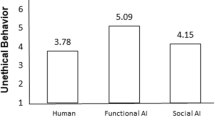Abstract
We present a robot that is working with humans on a common construction task. In this kind of interaction, it is important that the robot can perform different roles in order to realise an efficient collaboration. For this, we introduce embodied multimodal fusion, a new approach for processing data from the robot’s input modalities. Using this method, we implemented two different robot roles: the robot can take the instructive role, in which the robot mainly instructs the user how to proceed with the construction; or the robot can take the supportive role, in which the robot hands over assembly pieces to the human that fit to the current progress of the assembly plan. We present a user evaluation that researches how humans react to the different roles of the robot. The main findings of this evaluation are that the users do not prefer one of the two roles of the robot, but take the counterpart to the robot’s role and adjust their own behaviour according to the robot’s actions. The most influential factors for user satisfaction in this kind of interaction are the number of times the users picked up a building piece without getting an explicit instruction by the robot, which had a positive influence, and the number of utterances the users made themselves, which had a negative influence.


Similar content being viewed by others
References
Biddle B (1979) Role theory: expectations, identities, and behaviors. Academic Press, New York
Boves L, Neumann A, Vuurpijl L, Bosch L, Rossignol S, Engel R, Pfleger N (2004) Multimodal interaction in architectural design applications. In: Lecture notes in computer science, pp 384–390
Breazeal C (2004) Social interactions in HRI: the robot view. IEEE Trans Syst Man Cybern, Part C, Appl Rev 34(2):181–186
Chaimowicz L, Campos M, Kumar V (2002) Dynamic role assignment for cooperative robots. In: Proceedings of IEEE international conference on robotics and automation (ICRA’02), 2002, vol 1. IEEE, New York, pp 293–298
Clark H, Krych M (2004) Speaking while monitoring addressees for understanding. J Mem Lang 50(1):62–81
Cohen PR, Johnston M, McGee D, Oviatt S, Pittman J, Smith I, Chen L, Clow J (1997) Quickset: multimodal interaction for distributed applications. In: MULTIMEDIA ’97: proceedings of the fifth ACM international conference on multimedia. ACM Press, New York, pp 31–40
Cook C, Heath F, Thompson RL, Thompson B (2001) Score reliability in Web- or Internet-based surveys: unnumbered graphic rating scales versus Likert-type scales. Educ Psychol Meas 61(4):697–706
Dautenhahn K, Woods S, Kaouri C, Walters M, Koay K, Werry I (2005) What is a robot companion-friend, assistant or butler? In: IEEE/RSJ international conference on intelligent robots and systems (IROS 2005). IEEE, New York, pp 1192–1197
Foster ME, Matheson C (2008) Following assembly plans in cooperative, task-based human-robot dialogue. In: Proceedings of the 12th workshop on the semantics and pragmatics of dialogue (Londial 2008), London, June 2008
Foster M, Giuliani M, Isard A, Matheson C, Oberlander J, Knoll A (2009) Evaluating description and reference strategies in a cooperative human-robot dialogue system. In: International joint conference on artificial intelligence (IJCAI 2009), Pasadena, California, July 2009
Foster ME, Giuliani M, Knoll A (2009) Comparing objective and subjective measures of usability in a human-robot dialogue system. In: Proceedings of the 47th annual meeting of the Association for Computational Linguistics and the 4th international joint conference on natural language processing of the Asian Federation of Natural Language Processing (ACL-IJCNLP 2009), Singapore, August 2009
Gibson J (1986) The ecological approach to visual perception. Lawrence Erlbaum, Hillsdale
Giuliani M, Foster M, Isard A, Matheson C, Oberlander J, Knoll A (2010) Situated reference in a hybrid human-robot interaction system. In: International natural language generation conference (INLG 2010), Dublin, Ireland, July 2010
Hinds P, Roberts T, Jones H (2004) Whose job is it anyway? A study of human–robot interaction in a collaborative task. Hum-Comput Interact 19:151–181
Holzapfel H, Nickel K, Stiefelhagen R (2004) Implementation and evaluation of a constraint-based multimodal fusion system for speech and 3D pointing gestures. In: ICMI ’04: proceedings of the 6th international conference on multimodal interfaces. ACM Press, New York, pp 175–182
Johnston M, Bangalore S, Vasireddy G, Stent A, Ehlen P, Walker M, Whittaker S, Maloor P (2002) Match: an architecture for multimodal dialogue systems. In: Proceedings of the 40th annual meeting of the Association for Computational Linguistics, pp 376–383
Kipp M (2010) Multimedia annotation, querying and analysis in ANVIL. In: Multimedia information extraction
Krüger N, Piater J, Wörgötter F, Geib C, Petrick R, Steedman M, Ude A, Asfour T, Kraft D, Omrcen D et al (2009) A formal definition of object-action complexes and examples at different levels of the processing hierarchy. PACO+ technical report, available from http://www.paco-plus.org
Litman D, Pan S (2002) Designing and evaluating an adaptive spoken dialogue system. User Model User-Adapt Interact 12(2–3):111–137
Looije R, Neerincx M, Kruijff G (2007) Affective collaborative robots for safety & crisis management in the field. In: Intelligent human computer systems for crisis response and management (ISCRAM 2007), Delft, Netherlands, May 2007
Meyer S (2011) Mein Freund der Roboter: Servicerobotik für ältere Menschen—Eine Antwort auf den demographischen Wandel? VDE-Verlag, Berlin
Müller T, Ziaie P, Knoll A (2008) A wait-free realtime system for optimal distribution of vision tasks on multicore architectures. In: Proc 5th international conference on informatics in control, automation and robotics, May 2008
Persuadable research survey shows many willing to borrow money to buy a domestic robot, January 2012. http://www.prweb.com/releases/2012-market-research/robot-survey/prweb9140526.htm
Ross L, Amabile T, Steinmetz J (1977) Social roles, social control, and biases in social-perception processes. J Pers Soc Psychol 35(7):485–494
Sebanz N, Bekkering H, Knoblich G (2006) Joint action: bodies and minds moving together. Trends Cogn Sci 10(2):70–76
Sentis L, Khatib O (2004) Task-oriented control of humanoid robots through prioritization. In: Proceedings of the IEEE-RAS/RSJ international conference on humanoid robots
Stewart D, Stasser G (1995) Expert role assignment and information sampling during collective recall and decision making. J Pers Soc Psychol 69(4):619
Stiefelhagen R, Ekenel H, Fugen C, Gieselmann P, Holzapfel H, Kraft F, Nickel K, Voit M, Waibel A (2007) Enabling multimodal human–robot interaction for the Karlsruhe humanoid robot. IEEE Trans Robot 23(5):840–851
Stone P, Veloso M (1999) Task decomposition and dynamic role assignment for real-time strategic teamwork. In: Intelligent agents V: agents theories, architectures, and languages, pp 293–308
Tapus A, Mataric M (2008) Socially assistive robots: the link between personality, empathy, physiological signals, and task performance. In: AAAI Spring, vol 8
van Breemen AJN (2005) iCat: experimenting with animabotics. In: AISB 2005 creative robotics symposium
Wahlster W (2006) SmartKom: foundations of multimodal dialogue systems. Springer, Berlin
Walker M, Kamm C, Litman D (2000) Towards developing general models of usability with PARADISE. Nat Lang Eng 6(3–4):363–377
Ziaie P, Müller T, Knoll A (2008) A novel approach to hand-gesture recognition in a human-robot dialog system. In: Proceedings of the first intl workshop on image processing theory, tools & applications, Sousse, Tunesia, November 2008
Zimbardo P, Cross A (1971) Stanford prison experiment. Stanford University
Acknowledgements
This research was supported by the European Commission through the projects JAST (FP6-003747-IP) and JAMES (FP7-270435-STREP). Thanks to Sören Jentzsch for help in annotating the video data.
Author information
Authors and Affiliations
Corresponding author
Rights and permissions
About this article
Cite this article
Giuliani, M., Knoll, A. Using Embodied Multimodal Fusion to Perform Supportive and Instructive Robot Roles in Human-Robot Interaction. Int J of Soc Robotics 5, 345–356 (2013). https://doi.org/10.1007/s12369-013-0194-y
Accepted:
Published:
Issue Date:
DOI: https://doi.org/10.1007/s12369-013-0194-y




